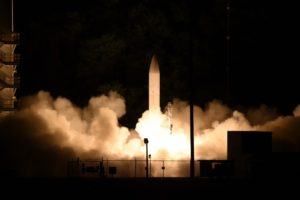The Army’s top hypersonic weapon official this week laid out the Pentagon’s next year testing schedule for the hypersonic weapon glide body to prepare to field it by fiscal year 2023.
“The flight test program is very aggressive and we need to be aggressive in order to keep on pace and really be competitive with our near peer competitors, namely Russia and China,” Lt. Gen. L. Neil Thurgood, Director of Hypersonics, Directed Energy, Space, and Rapid Acquisition in the Army, said during the Defense News Space and Missile Defense Symposium virtual debrief event on Wednesday.

Thurgood said the Pentagon will accelerate the program moving forward with three more flight tests in 2021.
In March, the Army and Navy jointly conducted the launch of the Common Hypersonic Glide Body (C-HGB) from the Pacific Missile Range Facility in Kauai, Hawaii to have the system fly at hypersonic speed to reach a designated impact point (Defense Daily, March 20).
“That flight test was designed to really focus on the glide body itself and we call that, what we’re fielding in FY ’23, the Block I glide body. So we’re building parts and pieces of that. So every flight test we’re getting closer and closer to the design we’re fielding,” Thurgood said.
He underscored, like all of the tests for the weapon, it was done for distance, speed, accuracy, and lethality. Thurgood reiterated it was “very successfully, it did exactly what we wanted it to do.”
The next flight test is scheduled to mid-2021 followed “very quickly” by two shots later in 2021.
“So next year our intent is to do several flight tests versus where we’ve basically…just completed a flight test once every three years. We’re going to accelerate that dramatically.”
The C-HGB is being designed by the Navy while the Army is overseeing production. The Navy plans to buy a common missile stack rocket booster to lift the glide body to the edge of space and the two parts combined make up the all-up round to be used by the Army and Navy. The Air Force plans to use the same glide body but a different launching system.
Thurgood also said starting in the fall 2021, the hypersonic weapon tests will include the units to help train the soldiers that will first field them.
At the pace they are moving, the Defense Department cannot limit tests with only a “single outcome, events have to be dual purpose and we have to use our resources wisely and we have to apply as many things at each event as we can without driving the risk up for success.”
This means the test will not only test the four main technical measurements but also training personnel on how to exercise the kill chain, identifying targets, and passing mission sets.
Separately, Thurgood said the DoD is proceeding well in transitioning the technology from government labs to commercial industrial partners to build the industrial base so they can produce the new weapons in quantity.
“We have collectively formed an industrial board of directors with our six prime companies that really were part of the [science and technology] community that have been working this for some time and now we’re building that to go forward. So we’re building an industrial base, which is unique.”
Thurgood noted there is no commercial industrial base for hypersonic glide bodies of missiles, so the government is helping create one with industry partners. The companies are working with Sandia National Laboratories to learn how to build the weapons.
Thurgood said over the next 12 to 14 months they will transition from Sandia to the first commercial provider of the hypersonic glide body vehicles, Leidos’ Dynetics [LDOS].
The Army awarded Dynetics a $352 million contract last August as the team lead to build the first 20 commercially manufactured C-HGB systems (Defense Daily, Aug. 30, 2019).
Thurgood noted training with Dynetics has been going on for about a year. Sandia has trained two complete Dynetics and supply chain groups and production will next transition to Dynetics producing the first glide body with Sandia overseeing the process.
Thurgood said they have a plan and contingency to repeat the process with a second glide body producer “should the demand signal be required that we need to produce more than we currently have planned.”
He said the demand signal is driven by DoD on how many glide bodies and all-up-rounds are needed in the future.
“At the same time we are about 14 months away from giving our first set of support equipment to the first unit as we do that, so it’s happening very, very quickly,” he added.